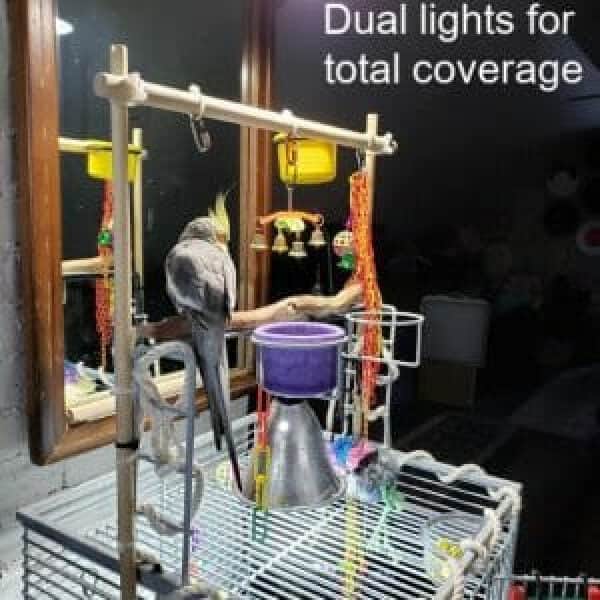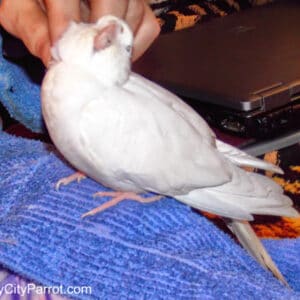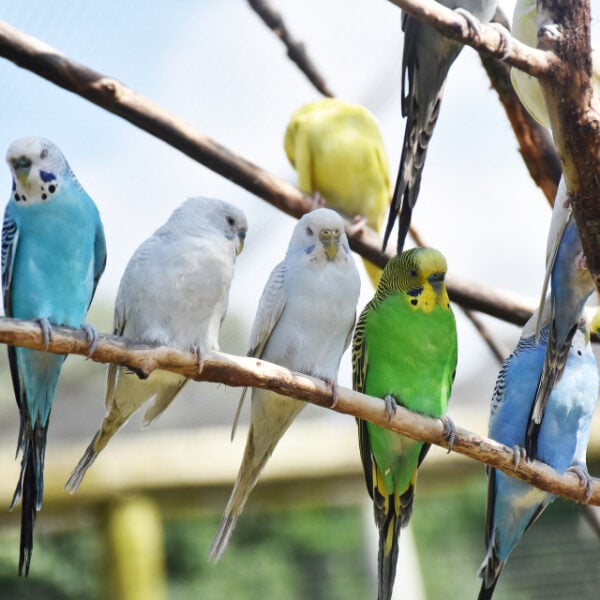Last Updated on by Catherine Tobsing
Having the responsibility of digital marketing for Windy City Parrot I Recently Googled the term “parrot care.”
A keyword phrase we need to rank for much better.
What singularly struck me was a mediocrity of information for the top-ranked links on page 1 of Google’s search results.
Unremarkably, for me, “parrots” were treated as a single species much like dogs.
These are some quotes
From: https://www.wikihow.pet/Care-for-a-Parrot
“Get your new parrot into its cage for the first time”
For an aggressive parrot or one that doesn’t know how to step up, you’ll need to get a hold of him to get him in his cage”…
From: https://www.herebird.com/owning-a-parrot/
The difference in size between a cage for a macaw and one for a conure is considerable.
Let’s mull that one over for a moment.
“Macaw”, that term is thrown about casually.
Macaws range from hyacinth macaws and 44 inches long to Noble macaws which are the size of sun conures.
giphy
So let’s give these folks the benefit of the doubt and assume they mean large macaws.
We’ve identified 43 species of large macaws – if you like to take a look we write about that here.
Does that mean I should not get a (large) macaw size cage (with appropriate bar spacing) for a conure?
Can a green cheek conure possibly cohabitate in a large aviary with a greenwing macaw ?
Depending on the type and breed, a pet parrot can cost anywhere from $100 to well over $1,000 dollars.
Depending on the size and style, a birdcage can cost anywhere from $100 to well over $1,000 dollars.
If you find a parrot in an animal shelter, you may only need to pay a small adoption fee.
My favorite was from http://www.exoticpetvet.com/general-parrot-care.html
The light must remain on for at least 6 hours a day.
The typical light period for these parrots is 10 hours of light to 14 hours of darkness.
The darkness, however, may be increased in hens that are overly reproductive.
Let’s take a step back for a moment.
Many of you have heard the term “nest box” or “nest box door.”
The term is misleading because of all the parrots on the planet the only one that builds a nest is the Quaker parrot or Monk parakeet.
Parrots generally live in the hollows of trees something we could talk about endlessly.
Some parrots live under rocks like the Patagonian Conure – I think.
A mantra that we preach here is “you need to think like a bird.”
Getting back to “The darkness, however, may be increased in hens that are overly reproductive”.
We’ll give the bird docs 50 points for at least mentioning the word “rescue”.
None of the other sites did.
We have to ask the question if parrots seek darkness to breed would not darkness encourage breeding?
Of course.
Light and light cycles can be used to discourage breeding and we’ll come back to that.
How many species of parrots and parakeets are there?
This is a question no one agrees on.
There are more than 120 conure species alone.
https://windycityparrot.com/many-conure-species-youd-amazed/
Here’s something you won’t find on the Internet – a growing list of every parrot and parakeet species on the planet.
https://windycityparrot.com/growing-list-every-parrot-parakeet-species-planet/
Some parrot care topics can be generalized but many cannot.
You cannot successfully serve a whole walnut to a cockatiel, thus food is not a generalized parrot care topic.
We talk about the cage canopy effect using bird toys to help with privacy in a birdcage which is generalized but bird toys cannot be generalized due to sizes.
Give a tennis ball to almost every breed of dog under the sun.
A bird toy that is appropriate in a green wing macaw cage would not be well-suited for a cockatiel’s cage.
Lovebirds are similar in size to parrotlets but they engage toys in entirely different ways.
Parrotlets are small parrots and like their toys in similar arrangements to larger parrots.
Lovebirds like to hang on the side of the cage when engaging with their bird toys.
That’s why the information we put forward is very species and subspecies specific, we don’t want to confuse anyone.
Now that we’ve established that bird cages, bird toys, bird food, and money other categories cannot be generalized, “what can” you ask?
The perception of light is more or less universal for all birds.
There’s so much bad information about light that is hard to break through all the noise.
We wrote Birds And Full Spectrum Lighting. We Got It Wrong.
https://windycityparrot.com/birds-full-spectrum-lighting-got-wrong/
In an attempt to begin to set the record straight.
One thing we have learned is that by placing a light source over your bird’s cage no more than 6 inches from the top, then placing it on a timer for 12 hours of light and 12 hours of darkness we can stabilize many of your bird’s hormonal issues.
Basically, we replicate summer in Australia all year round. Birds don’t mate or breed in the summer.
We can stop a prolific egg-laying bird in a cage for 72 hours with constant lighting.
It breaks their circadian rhythm.
The same circadian rhythm, essentially that makes humans SAD in the winter.
Recommended relief is light therapy so it’s certainly not a stretch to send that to birds and even other species.
A larger problem is that parrots have had 120 million years of instinctual expectations.
Birds ability to see light beyond the visible spectrum (for humans), UVA and UVB one of many signals pet birds may be missing.
No ultraviolet light can penetrate your home’s windows, so visual information is missing.
In the wild, signals from moonlight affect birds in many ways.
An article from Wingspan Optics they state “Lunar cycles seem to affect many of the rhythms, temporal patterns and behaviors of birds and other living things on Earth.
Ambient light is known to affect visual communication in birds, with the conspicuousness of visual signals being largely determined by the light available for reflection by the sender”.
https://wingspanoptics.com/blogs/field-journal/how-the-moon-affects-birds
Our pet birds never see moonlight and understanding how lacking lunar cycles and light affects our birds, is something we may never know.
Bathing is another topic that can be generally applied to pet birds.
The bird in your cage can have anywhere from 3000 to 5000 feathers (budgie) or 5000 to 8000 feathers (Camelot macaw).
In any natural habitat, birds will seek ways to bathe. Water helps keep these feathers in much better condition than neglect offering a bath or even a gentle spray misting. as you can clearly see.
Circling back to the premise of this discussion, there are very few topics apply to parrot care with broad brush strokes.
These are animals that can fly.
A fact that only begins to define their complexity and the need to be species-specific (remember there is only one species of dog) when learning to care for pet birds.
Please subscribe to our Sunday birdie brunch for a weekly buffet of granular parrot care solutions.
Author Profile
Latest entries
 The Traveling BirdJune 26, 2025Can You Name 5 Parrot Species That Are Living Wild in the USA?
The Traveling BirdJune 26, 2025Can You Name 5 Parrot Species That Are Living Wild in the USA? Bird BehaviorJune 26, 2025How is it Parrots Are Problem Solvers Social Animals and Even Use Tools?
Bird BehaviorJune 26, 2025How is it Parrots Are Problem Solvers Social Animals and Even Use Tools? Bird & Parrot AnatomyJune 25, 2025How a Tiny Chemical Modification Makes Parrots Nature’s Living Paintings
Bird & Parrot AnatomyJune 25, 2025How a Tiny Chemical Modification Makes Parrots Nature’s Living Paintings PigeonsJune 20, 2025How Do Parrots Thrive in Cities Outside Their Native Habitats?
PigeonsJune 20, 2025How Do Parrots Thrive in Cities Outside Their Native Habitats?




